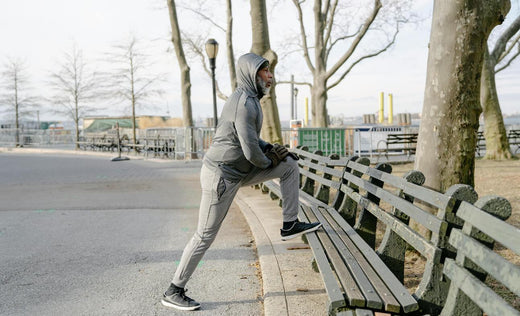
How Older Athletes Stay Unstoppable
Aging brings about inevitable changes in the body, many of which can significantly affect athletic performance. Three key factors — declining VO₂ max, muscle mass loss, and weight gain — play a substantial role in shaping the ability of older endurance athletes to compete and perform. Understanding how these factors impact performance and implementing strategies to mitigate their effects can help athletes thrive well into their later years.
1. VO₂ Max Decline
Understanding VO₂ Max
VO₂ max, or maximal oxygen uptake, measures the body’s ability to deliver and utilize oxygen during intense exercise. It is a critical determinant of endurance performance, as oxygen is essential for energy production in aerobic activities.
The Impact of Aging on VO₂ Max
VO₂ max naturally declines with age due to physiological changes such as reduced cardiac output, diminished lung function, and decreased muscle mitochondrial efficiency. Research indicates that VO₂ max decreases by approximately 5–10% per decade after age 30, with the decline accelerating after 70. For endurance athletes, this means reducing their ability to sustain high-intensity efforts and overall endurance capacity.
Mitigation Strategies for VO₂ Max Decline
The good news is that regular training can slow the decline in VO₂ max. Studies show that older athletes who engage in high-intensity interval training (HIIT) or other forms of cardiovascular exercise can maintain higher levels of VO₂ max compared to sedentary peers.
Incorporate Interval Training. Adding intervals of intense effort followed by recovery periods can stimulate improvements in cardiac output and oxygen utilization
Consistent Endurance Training: Regular long-duration, moderate-intensity activities such as cycling, swimming, or running can help preserve cardiovascular health and VO₂ max.
Strength Training for Cardiac Health: Resistance training improves overall circulation and indirectly supports cardiovascular efficiency, which can benefit VO₂ max.
2. Muscle Mass Loss (Sarcopenia)
Understanding Sarcopenia
Sarcopenia refers to the age-related loss of muscle mass and strength. This process typically begins in the 30s and accelerates with each passing decade. By 80, individuals can lose up to 30% of their muscle mass.
The Impact on Performance
For athletes, reduced muscle mass translates into lower strength, endurance, and power output. Muscle loss also impacts recovery and increases the risk of injury, making it harder to maintain consistent training routines. A weakened musculoskeletal system can further affect biomechanics, leading to inefficiencies in movement and a more significant energy cost for physical activities.
Mitigation Strategies for Muscle Loss
Resistance training is the cornerstone of combating sarcopenia. Studies show that older adults who engage in regular strength training can preserve muscle mass and even rebuild lost strength.
Incorporate Strength Training: Aim for 2–3 weekly sessions, focusing on compound movements like squats, deadlifts, and bench presses, which work for multiple muscle groups.
Prioritize Protein Intake: Adequate dietary protein (1.2–1.6 grams per kilogram of body weight daily) is essential for muscle repair and growth. Protein-rich foods, such as lean meats, dairy, legumes, and plant-based options, can support muscle health.
Use Progressive Overload: Gradually increasing the weight or resistance in exercises ensures continuous muscle adaptation and growth.
3. Weight Gain
The Connection Between Aging and Weight Gain
As metabolism slows with age, maintaining a healthy weight becomes more challenging. Hormonal changes, reduced physical activity, and dietary shifts often increase fat mass. This additional weight—especially if it’s fat rather than muscle—can significantly impact performance for athletes.
The Impact on Performance
Weight gain affects endurance performance in multiple ways:
VO₂ Max Decrease: VO₂ max is often expressed relative to body weight (mL/kg/min). Even if absolute VO₂ max remains stable, weight gain can lower relative VO₂ max, reducing aerobic capacity.
Reduced Efficiency: Carrying extra weight increases the energy cost of movement, leading to faster fatigue.
Higher Injury Risk: Additional weight strains joints, increasing the likelihood of overuse injuries.
Mitigation Strategies for Weight Gain
Maintaining an active lifestyle and a balanced diet are critical for managing weight effectively.
Monitor Caloric Intake: Adjusting calorie consumption to align with activity levels can prevent unwanted weight gain. Tracking apps or consulting with a dietitian can help ensure proper energy balance.
Focus on Nutrient-Dense Foods: Emphasize whole, unprocessed foods like fruits, vegetables, lean proteins, and whole grains to maintain a healthy weight and fuel performance.
Combine Aerobic and Strength Training: Resistance training builds muscle, which increases resting metabolic rate, while aerobic exercise helps burn calories and manage fat.
A Holistic Approach
While each factor — VO₂ max decline, muscle loss, and weight gain — can independently impact performance, they often interact to compound the effects of aging. For example, weight gain can exacerbate VO₂ max decline, and muscle loss can make it harder to maintain the activity needed for weight management.
Older athletes should adopt a holistic approach that combines cardiovascular exercise, resistance training, and proper nutrition to counteract these challenges — additionally, adequate recovery, hydration, and sleep support overall performance and longevity.
Aging is an unavoidable part of life, but it doesn’t have to mean the end of athletic performance. By understanding the key factors that impact endurance — VO₂ max decline, muscle loss, and weight gain — and taking proactive steps to address them, older athletes can continue to excel in their sports. Regular training, mindful nutrition, and a commitment to lifelong fitness can help athletes maintain their performance and enjoy the physical and mental benefits of staying active as they age.


